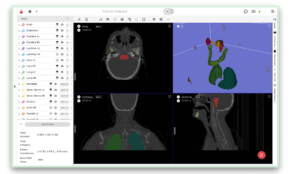Radiology is leading the charge in medical AI, with startups and healthcare providers racing to build FDA-cleared tools for early diagnosis, triage automation, and surgical planning. Beyond diagnostics, annotated radiology data is also powering advances in surgical planning, treatment response modeling, and digital twin development, where accuracy is non-negotiable.
But even the most promising algorithm is only as good as the data it’s trained on. Poor-quality annotations can lead to inaccurate predictions or, worse, regulatory setbacks. That’s why high-quality, expert-reviewed radiology annotations are mission-critical.

Unlike generic image datasets, radiology data requires domain expertise, format-specific tooling (such as DICOM), and integration with hospital systems (like PACS). That’s why choosing the right radiology annotation tool is so important.
Key Features to Look for in Radiology Annotation Tools
Before we dive into the list, here’s what separates a basic image annotation tool from one designed for radiology AI:
- Native support for DICOM, NRRD, and NIfTI formats with pixel-level annotation precision, including full viewing and metadata handling for .dcm files.
- Compatibility with multiple imaging modalities such as X-ray, CT, MRI, and PET.
- Smooth integration with clinical systems like PACS to enable seamless workflow interoperability.
- Expert workflows supporting multi-reader annotation, consensus reviews, and inter-rater scoring for improved annotation quality and reliability.
- Regulatory readiness with HIPAA and GDPR compliant data handling, audit trails, and secure infrastructure.
- Flexible deployment options include on-premises, hybrid cloud, and private cloud setups.
- Integrated automation combined with expert human review (human-in-the-loop) to enhance annotation accuracy and efficiency.
1. iMerit Ango Hub

Ango Hub by iMerit is purpose-built for complex healthcare workflows. It supports DICOM, NRRD, and NIfTI formats and includes advanced QA tools, annotation scoring, and automation-assisted labeling. Integrated with expert medical annotators, including radiologists, Ango Hub is ideal for AI teams building FDA-grade radiology solutions.
Key Features:
- Full DICOM support with pixel-level annotation: Handles DICOM, NRRD, and NIfTI formats with lossless image rendering, metadata preservation, and tools for slice-by-slice or volumetric segmentation, ensuring pixel-perfect accuracy for CT, MRI, X-ray, and PET scans.
- On-prem, hybrid, or private cloud deployments: Flexible infrastructure options meet strict hospital IT and compliance requirements, enabling secure integration with existing PACS systems while keeping PHI fully controlled.
- Consensus-based review pipelines: Built-in multi-reader workflows allow multiple radiologists to annotate the same case, automatically calculating agreement scores and surfacing discrepancies for resolution, improving inter-rater reliability.
- HIPAA-compliant infrastructure: Enterprise-grade security with encryption at rest and in transit, detailed audit logs, and role-based access control, meeting HIPAA and GDPR requirements for clinical data handling.
- Automation + human-in-the-loop workflows: Combines AI-powered pre-labeling, active learning to surface complex edge cases, and automated QA checks with expert radiologist oversight, accelerating throughput without compromising clinical precision.
Unlike most platforms that rely on generic QA or internal reviewers, Ango Hub embeds consensus validation and scoring from certified radiologists, ensuring annotation quality meets clinical-grade standards.
What sets iMerit apart is its dedicated team of certified radiologists and medical experts who perform consensus validation and scoring, ensuring that annotation quality consistently meets clinical-grade standards. This human-in-the-loop approach combines expert oversight with automation to maintain precision and improve annotation consistency over time.
2. MD.ai
A tool used in clinical and research settings, MD.ai provides a DICOM viewer with multi-reader workflows and audit logs. It supports structured annotation templates and consensus reviews.
Key Features:
- Native DICOM viewer supporting multiple imaging modalities
- Structured annotation templates to ensure consistent labeling
- Multi-reader support for consensus and inter-rater reliability analysis
- Comprehensive audit logs tracking all annotation activities
- Workflow designed to support clinical research and regulatory requirements
3. Encord
Encord supports DICOM and other medical imaging formats, enabling annotation pipelines that include AI-assisted labeling and active learning. The platform is designed to handle large datasets and supports collaboration and quality control workflows.
Key Features:
- Compatibility with DICOM and multimodal medical imaging formats
- AI-assisted annotation to accelerate labeling tasks
- Active learning workflows to prioritize data requiring expert attention
- Scalable pipeline architecture suitable for large datasets
- Collaboration features allow teams to review and correct annotations continuously
4. RedBrick AI
RedBrick AI provides tools for annotating CT, MRI, and X-ray images with support for DICOM segmentation. It includes interpolation features, 3D segmentation capabilities, version control, and supports regulatory-compliant deployments.
Key Features:
- DICOM segmentation tools supporting 2D and 3D imaging data
- Interpolation features to efficiently annotate across slices
- Annotation version control to track edits and maintain history
- Compliance support for regulatory standards through audit trails
- Active learning integration for improving annotation throughput and accuracy
5. Cogito Tech
Cogito Tech provides AI-assisted annotation tools with a focus on medical imaging workflows. It offers collaboration features that facilitate coordinated work between radiologists and data scientists. The platform emphasizes quality control with automated checks and review processes designed for clinical research environments, helping ensure the integrity of annotated datasets.
Key Features:
- Annotation tools tailored to medical imaging modalities
- AI-assisted workflows to improve labeling efficiency
- Collaboration features supporting teamwork among clinicians and annotators
- Automated quality control checks integrated into annotation pipelines
- Designed to meet the needs of clinical research and regulatory compliance
6. Keylabs.ai
Keylabs.ai offers tools for annotation and data curation specifically aimed at medical datasets. The platform incorporates automation features to reduce manual effort while improving annotation consistency. It supports data quality management workflows to validate and standardize annotations, making it suitable for healthcare AI projects requiring reliable labeled data.
Key Features:
- Annotation and data curation tools for medical imaging datasets
- Automation-assisted labeling to streamline manual work
- Quality management workflows to ensure data consistency
- Support for various medical imaging formats
- Designed to support healthcare AI development and regulatory needs
7. v7 Labs
v7 Labs is a versatile annotation platform that supports a wide range of data types, including medical imaging. It provides flexible annotation tools such as bounding boxes, polygons, and segmentation masks, which can be adapted for radiology projects. The platform offers integration APIs to connect with external systems and supports collaborative workflows across teams. While not exclusively healthcare-focused, it is increasingly used in medical AI applications.
Key Features:
- Flexible annotation types including bounding boxes, polygons, and masks
- Support for medical imaging alongside other data modalities
- Integration APIs for workflow customization and automation
- Collaboration tools to facilitate team-based annotation
- Suitable for generalist projects, including medical AI
Conclusion: Choosing the Right Radiology Annotation Tool
Selecting the right radiology annotation tool is essential for building accurate, reliable, and compliant medical AI solutions. iMerit’s Ango Hub offers a comprehensive platform purpose-built for healthcare workflows, combining full support for medical imaging formats with expert-in-the-loop validation and automation. Its secure, HIPAA-compliant infrastructure and flexible deployment options make it well-suited for clinical research and enterprise-grade AI development.
From PACS integration to automation, if you are developing radiology AI for real-world clinical use, not just testing models, Ango Hub combines HIPAA-compliant infrastructure, automation, and medical expert oversight to make your data production-ready and regulator-ready. It’s annotation with precision, at the clinical level, empowering AI developers to focus on innovation with confidence in their data foundation.
Explore how Ango Hub can power your radiology AI pipeline: Learn More
